Abstract
OBJECTIVE--To determine the prognostic significance of altered plasma viscosity and erythrocyte aggregation in unstable angina. DESIGN--A prospective study of 96 consecutive patients with unstable angina allocated to one of two groups according to predefined threshold values for plasma viscosity and erythrocyte aggregation at study entry. The patients received a standardised treatment and were followed up for six months or until angioplasty or bypass surgery. MAIN OUTCOME MEASURE--Frequency of myocardial infarction. RESULTS--Myocardial infarctions occurred in 7/26 patients with a plasma viscosity greater than or equal to 1.38 mPa s and in 8/35 with a rate constant of erythrocyte aggregate formation greater than or equal to 0.5 mPa (corrected for plasma viscosity) but in only 4/70 with a plasma viscosity less than 1.38 mPa s and in 3/61 with an erythrocyte aggregation less than 0.5 mPa (odds ratios: 6.1 (95% confidence interval 1.3 to 31), p = 0.008, and 5.7 (95% CI 1.2 to 35), p = 0.016). Plasma viscosity and erythrocyte aggregation were more predictive of myocardial infarction than age, male gender, fibrinogen concentration, ST segment abnormalities, or coronary score. Furthermore, Holter monitoring with ST segment analysis showed that ischaemic episodes were more common in patients in whom the rate constant of erythrocyte aggregate formation was greater than 0.5 mPa (15/27 v 17/50, p = 0.029). Cardiac troponin T release was increased in patients with a plasma viscosity of greater than 1.38 mPa s (10/26 v 9/70, p = 0.010). CONCLUSIONS--In patients with unstable angina a considerable increase in plasma viscosity and erythrocyte aggregation identified a subgroup of patients at a high risk of acute myocardial infarction in whom medical treatment was likely to be unsuccessful.
Full text
PDF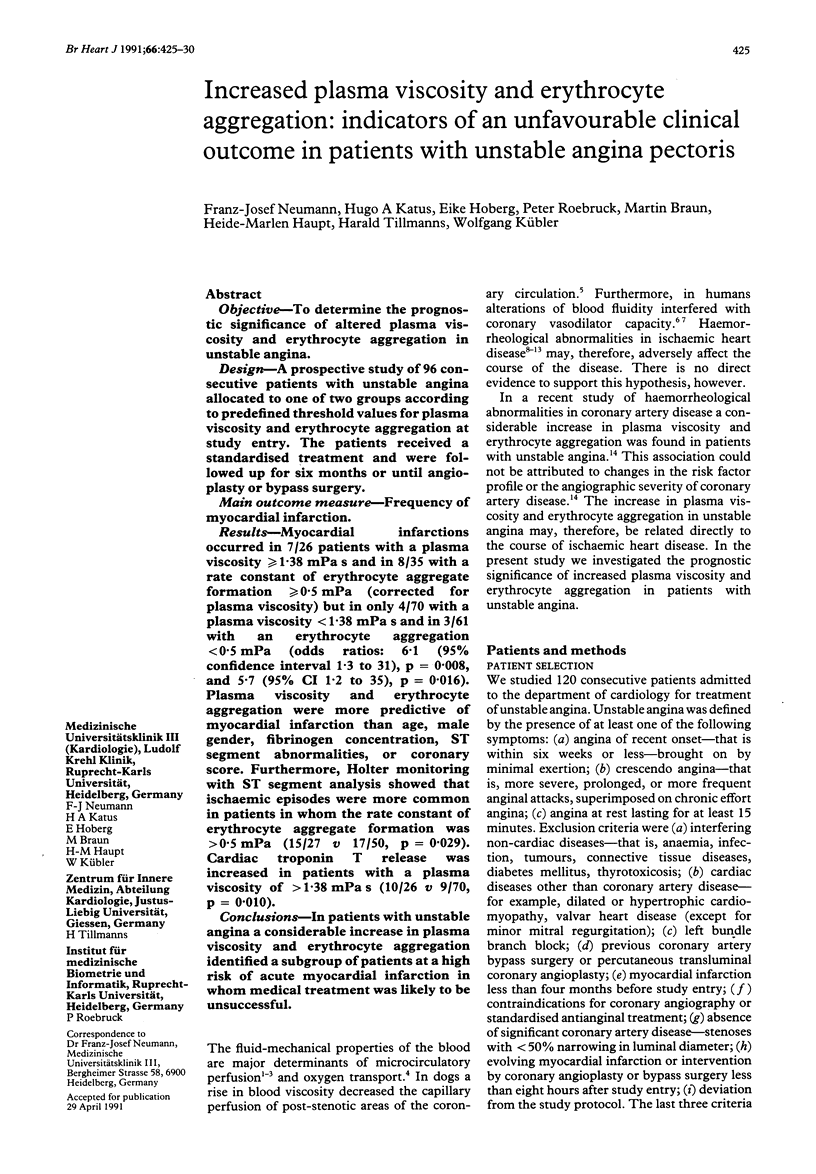
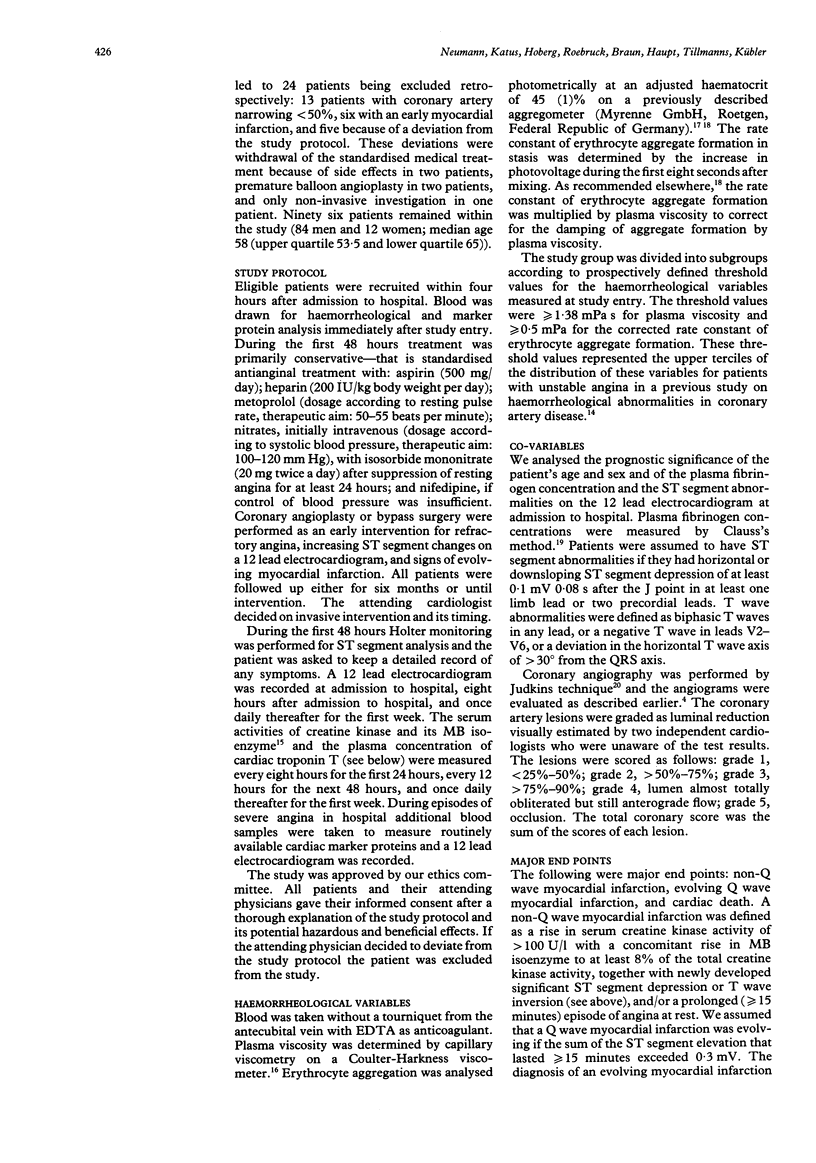
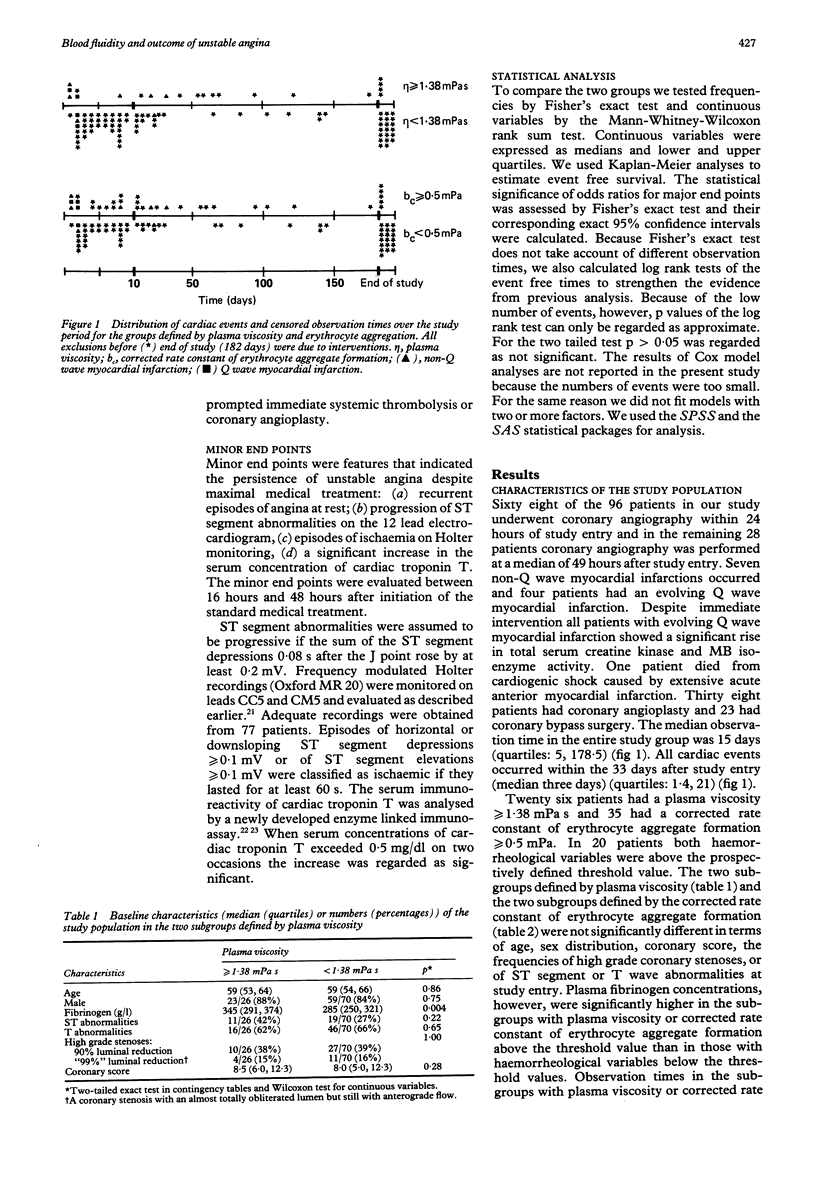
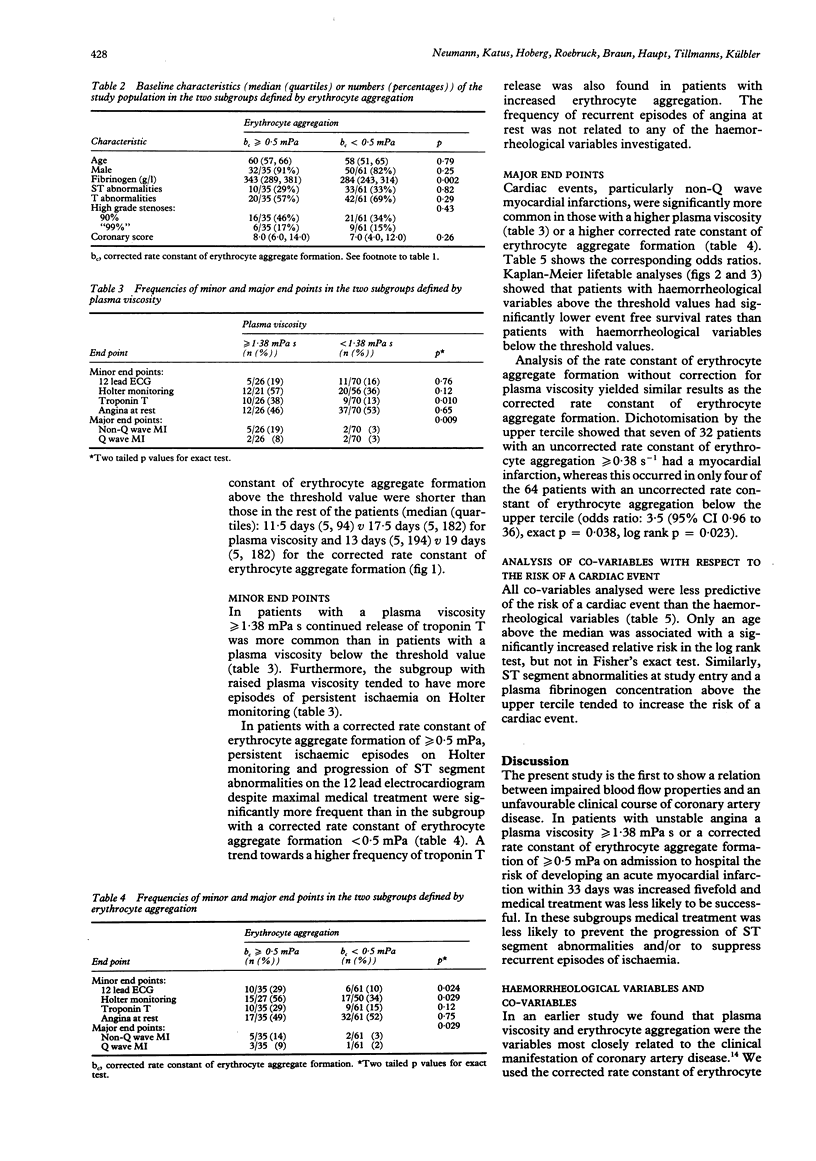
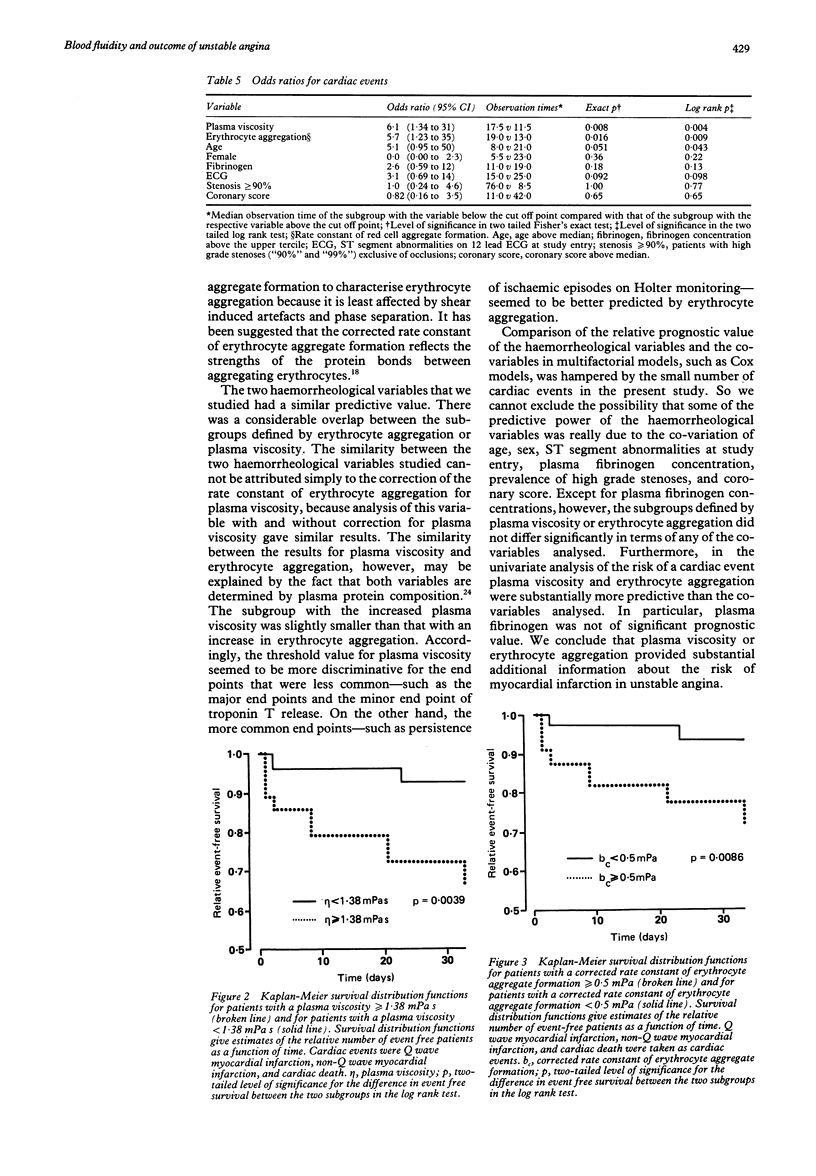
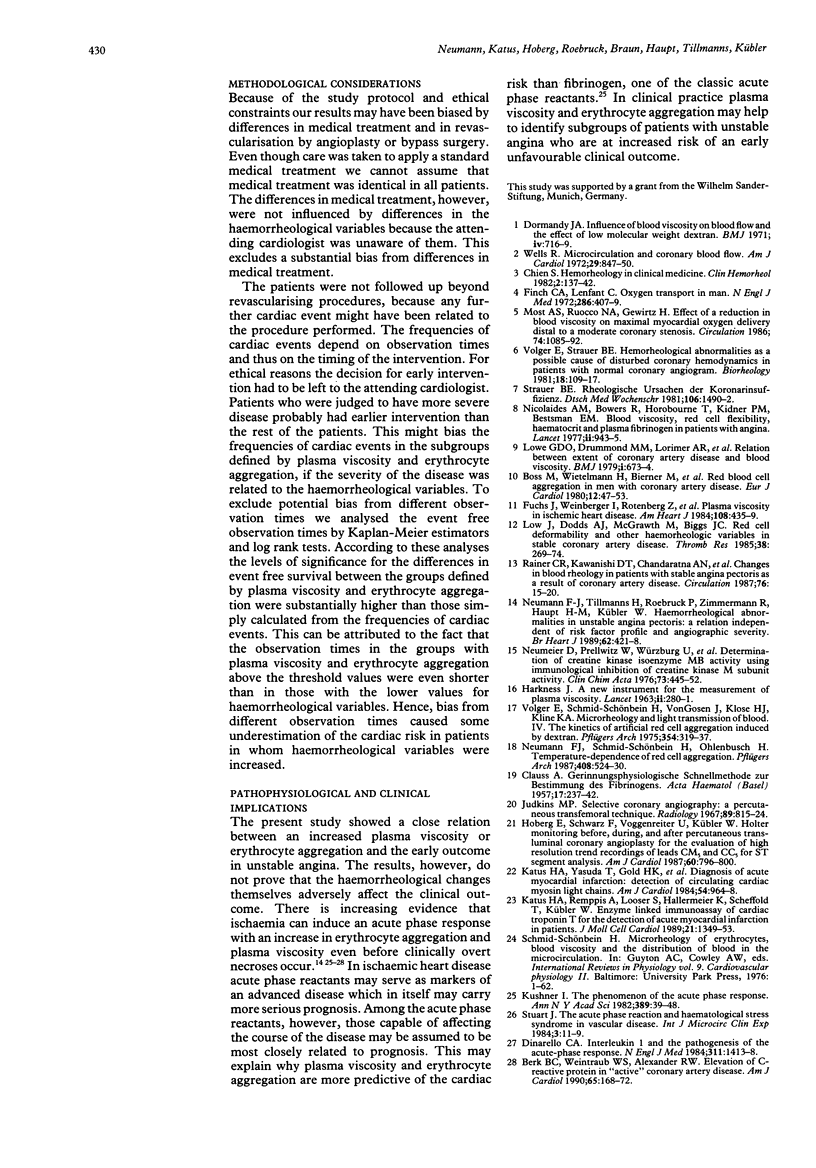
Selected References
These references are in PubMed. This may not be the complete list of references from this article.
- Berk B. C., Weintraub W. S., Alexander R. W. Elevation of C-reactive protein in "active" coronary artery disease. Am J Cardiol. 1990 Jan 15;65(3):168–172. doi: 10.1016/0002-9149(90)90079-g. [DOI] [PubMed] [Google Scholar]
- Boss N., Wietelmann H., Bierner M., Rudolph W., Schlepper M., Koenig-Erich S., Ruhenstroth-Bauer G. Red blood cell aggregation in men with coronary artery disease. Eur J Cardiol. 1980;12(1):47–54. [PubMed] [Google Scholar]
- CLAUSS A. Gerinnungsphysiologische Schnellmethode zur Bestimmung des Fibrinogens. Acta Haematol. 1957 Apr;17(4):237–246. doi: 10.1159/000205234. [DOI] [PubMed] [Google Scholar]
- Dinarello C. A. Interleukin-1 and the pathogenesis of the acute-phase response. N Engl J Med. 1984 Nov 29;311(22):1413–1418. doi: 10.1056/NEJM198411293112205. [DOI] [PubMed] [Google Scholar]
- Dormandy J. A. Influence of blood viscosity on blood flow and the effect of low molecular weight dextran. Br Med J. 1971 Dec 18;4(5789):716–719. doi: 10.1136/bmj.4.5789.716. [DOI] [PMC free article] [PubMed] [Google Scholar]
- Finch C. A., Lenfant C. Oxygen transport in man. N Engl J Med. 1972 Feb 24;286(8):407–415. doi: 10.1056/NEJM197202242860806. [DOI] [PubMed] [Google Scholar]
- Fuchs J., Weinberger I., Rotenberg Z., Erdberg A., Davidson E., Joshua H., Agmon J. Plasma viscosity in ischemic heart disease. Am Heart J. 1984 Sep;108(3 Pt 1):435–439. doi: 10.1016/0002-8703(84)90405-8. [DOI] [PubMed] [Google Scholar]
- HARKNESS J. A new instrument for the measurement of plasma-viscosity. Lancet. 1963 Aug 10;2(7302):280–281. doi: 10.1016/s0140-6736(63)90177-6. [DOI] [PubMed] [Google Scholar]
- Hoberg E., Schwarz F., Voggenreiter U., Kuebler W. Holter monitoring before, during and after percutaneous transluminal coronary angioplasty for evaluation of high-resolution trend recordings of leads CM5 and CC5 for ST-segment analysis. Am J Cardiol. 1987 Oct 1;60(10):796–800. doi: 10.1016/0002-9149(87)91026-5. [DOI] [PubMed] [Google Scholar]
- Judkins M. P. Selective coronary arteriography. I. A percutaneous transfemoral technic. Radiology. 1967 Nov;89(5):815–824. doi: 10.1148/89.5.815. [DOI] [PubMed] [Google Scholar]
- Katus H. A., Remppis A., Looser S., Hallermeier K., Scheffold T., Kübler W. Enzyme linked immuno assay of cardiac troponin T for the detection of acute myocardial infarction in patients. J Mol Cell Cardiol. 1989 Dec;21(12):1349–1353. doi: 10.1016/0022-2828(89)90680-9. [DOI] [PubMed] [Google Scholar]
- Katus H. A., Yasuda T., Gold H. K., Leinbach R. C., Strauss H. W., Waksmonski C., Haber E., Khaw B. A. Diagnosis of acute myocardial infarction by detection of circulating cardiac myosin light chains. Am J Cardiol. 1984 Nov 1;54(8):964–970. doi: 10.1016/s0002-9149(84)80126-5. [DOI] [PubMed] [Google Scholar]
- Kushner I. The phenomenon of the acute phase response. Ann N Y Acad Sci. 1982;389:39–48. doi: 10.1111/j.1749-6632.1982.tb22124.x. [DOI] [PubMed] [Google Scholar]
- Low J., Dodds A. J., McGrath M., Biggs J. C. Red cell deformability and other haemorheological variables in stable coronary artery disease. Thromb Res. 1985 May 1;38(3):269–276. doi: 10.1016/0049-3848(85)90155-0. [DOI] [PubMed] [Google Scholar]
- Most A. S., Ruocco N. A., Jr, Gewirtz H. Effect of a reduction in blood viscosity on maximal myocardial oxygen delivery distal to a moderate coronary stenosis. Circulation. 1986 Nov;74(5):1085–1092. doi: 10.1161/01.cir.74.5.1085. [DOI] [PubMed] [Google Scholar]
- Neumann F. J., Schmid-Schönbein H., Ohlenbusch H. Temperature-dependence of red cell aggregation. Pflugers Arch. 1987 May;408(5):524–530. doi: 10.1007/BF00585080. [DOI] [PubMed] [Google Scholar]
- Neumann F. J., Tillmanns H., Roebruck P., Zimmermann R., Haupt H. M., Kübler W. Haemorrheological abnormalities in unstable angina pectoris: a relation independent of risk factor profile and angiographic severity. Br Heart J. 1989 Dec;62(6):421–428. doi: 10.1136/hrt.62.6.421. [DOI] [PMC free article] [PubMed] [Google Scholar]
- Neumeier D., Prellwitz W., Würzburg U., Brundobler M., Olbermann M., Just H-J, Knedel M., Lang H. Determination of creatine kinase isoenzyme MB activity in serum using immunological inhibition of creatine kinase M subunit activity. Activity kinetics and diagnostic significance in myocardial infarction. Clin Chim Acta. 1976 Dec;73(3):445–451. doi: 10.1016/0009-8981(76)90146-7. [DOI] [PubMed] [Google Scholar]
- Nicolaides A. N., Horbourne T., Bowers R., Kidner P. H., Besterman E. M. Blood viscosity, red-cell flexibility, haematocrit, and plasma-fibrinogen in patients with angina. Lancet. 1977 Nov 5;2(8045):943–945. doi: 10.1016/s0140-6736(77)90886-8. [DOI] [PubMed] [Google Scholar]
- Rainer C., Kawanishi D. T., Chandraratna P. A., Bauersachs R. M., Reid C. L., Rahimtoola S. H., Meiselman H. J. Changes in blood rheology in patients with stable angina pectoris as a result of coronary artery disease. Circulation. 1987 Jul;76(1):15–20. doi: 10.1161/01.cir.76.1.15. [DOI] [PubMed] [Google Scholar]
- Schmid-Schönbein H. Microrheology of erythrocytes, blood viscosity, and the distribution of blood flow in the microcirculation. Int Rev Physiol. 1976;9:1–62. [PubMed] [Google Scholar]
- Strauer B. E. Rheologische Ursachen der Koronarinsuffizienz. Dtsch Med Wochenschr. 1981 Nov 6;106(45):1487–1490. doi: 10.1055/s-2008-1070539. [DOI] [PubMed] [Google Scholar]
- Volger E., Schmid-Schönbein H., Gosen J. v., Klose H. J., Kline K. A. Microrheology and light transmission of blood. IV. The kinetics of artificial red cell aggregation induced by Dextran. Pflugers Arch. 1975;354(4):319–337. doi: 10.1007/BF00587850. [DOI] [PubMed] [Google Scholar]
- Wells R. Microcirculation and coronary blood flow. Am J Cardiol. 1972 Jun;29(6):847–850. doi: 10.1016/0002-9149(72)90505-x. [DOI] [PubMed] [Google Scholar]


